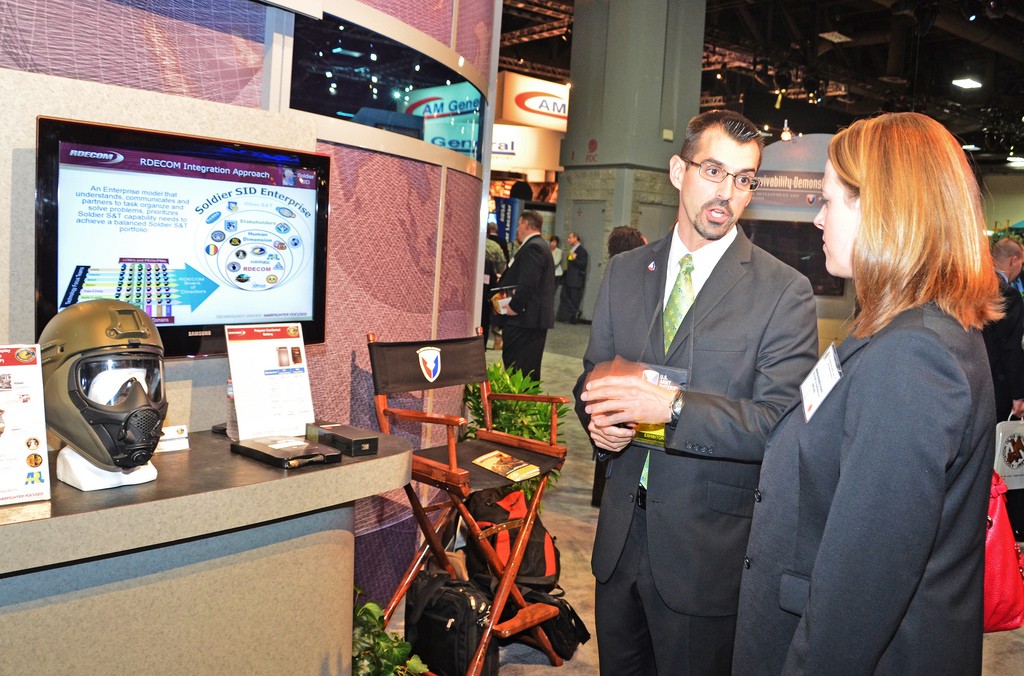
WASHINGTON -- Imagine a future when a Soldier's helmet is an integrated communications center with a heads-up computer display, night vision, thermal sensors and enhanced hearing. That future is nearer than many think.
During the 2010 Association of the United States Army Annual Meeting Oct. 25-27 at the Washington Convention Center, civilian researchers from the Natick Soldier Research, Development and Engineering Center displayed futurist equipment design concepts to senior Army leaders, congressional staffers and Soldiers attending the show.
"What we're trying to do is tell the story of how we're setting the force for the future," said Jean-Louis "Dutch" DeGay, Strategic Outreach, Natick Soldier RDEC.
DeGay said his focus is on the Soldier Domain, or everything that has to do with the individual Warfighter, such as uniforms, helmets and body armor. The NSRDEC works closely with other RDECOM centers to integrate electronics, night vision and computing power.
Army researchers consider the Soldier the most powerful weapon in the inventory.
"Our end-state, as I've always said, is to develop the F-16 on legs," DeGay said. "We need to build that platform around the Soldier. We do that with vehicles and we do that with aircraft, but we don't historically do that with Soldiers."
At the Army Materiel Command booth, DeGay shows concept helmet designs. The concept helmets show integrated headgear capabilities greater than the Advanced Combat Helmet and Combat Vehicle Crewman helmets currently being used in theater. Pre-molded rails on the sides offer a way to easily mount a chemical-biological protective mask. On the front, the helmet is molded to rapidly attach night vision or thermal sensor devices.
The Army conducts extensive interviews and technology demonstrations to generate feedback from Warfighters returning from Afghanistan and Iraq.
"We integrate Soldier feedback into our design principles," DeGay said. "They're happy. Soldiers are always excited to see something wearable."
DeGay said feedback drives the science and technology investments that has led them to build a modular, upgradable helmet of the future.
"When the Soldier gets the helmet they will say, 'Oh, this is my base platform with all these pieces that are already pre-molded,'" he said. "What my Soldier in theater is doing right now is buying these rails aftermarket and bolting them onto the helmet. If they want mounting platforms, why don't we make the extra effort to mold the helmet to accommodate those'"
The Research, Development and Engineering Command approaches its mission in the same way large corporations might.
"We're working together in an enterprise approach, which is a little bit different from how it has traditionally been done inside DoD, and it's more of what our industry partners do," DeGay said. "You have a large company that owns a number of subsidiary companies and they all work together for a final product."
The end product is the result of research done at multiple laboratories such as the Edgewood Chemical Biological Center at Aberdeen Proving Ground, Md., the Communications-Electronics Research, Development and Engineering Center, also at APG, and the Army Research Laboratory at Adelphi, Md. as well as NSRDEC in Massachusetts.
"We develop next generation helmets, next generation body armor, on-board electronics and we work with all the other partners inside the RDECOM portfolio as we develop them," DeGay said.
The helmet project is known as an Advanced Technology Objective, or ATO. Army researchers develop the product to a point of viability.
"We're in the concept phase right now," DeGay said. "We're responsible for the science and technology, not the production and maintenance. What we'll do as part of a science exploration with the ATO is find out what shows promise, take that and present it to Program Executive Office Soldier and say, 'We've matured this to x-level.' If they think this has viability then they will continue to mature the product and go out and compete, award and maintain the item out to the Army."
Natick researchers, and their partners across RDECOM, get the ball rolling.
At the AUSA meeting many people stop by to see the technology displays.
"Certainly when you do an event like this you get very lucky in that you get the senior Army leadership on the floor walking around," DeGay said. "We want to be able to make the senior leadership aware of what it is that we're doing, how we have a plan for science and technology investment for the next one, two, three, or five years. First and foremost, it's information awareness."
DeGay is a former Special Forces Soldier who knows what Warfighters face in the field.
"The reason I'm working at the NSRDEC is because I want to work on next generation equipment that lessens the Soldier's burden while increasing effectiveness," he said. "I'm very proud of the work we do."
DeGay said many people get enamored with aircraft and vehicles and forget about the dismounted Soldier.
"We want to make sure everyone is aware of the research we're doing for the Soldier," he said. "It gives them greater protection, greater capabilities and ultimately makes them more combat effective."
Related Links:
Army Science and Technology News
Research, Development and Engineering Command
Communications-Electronics Research, Development and Engineering Center

Social Sharing